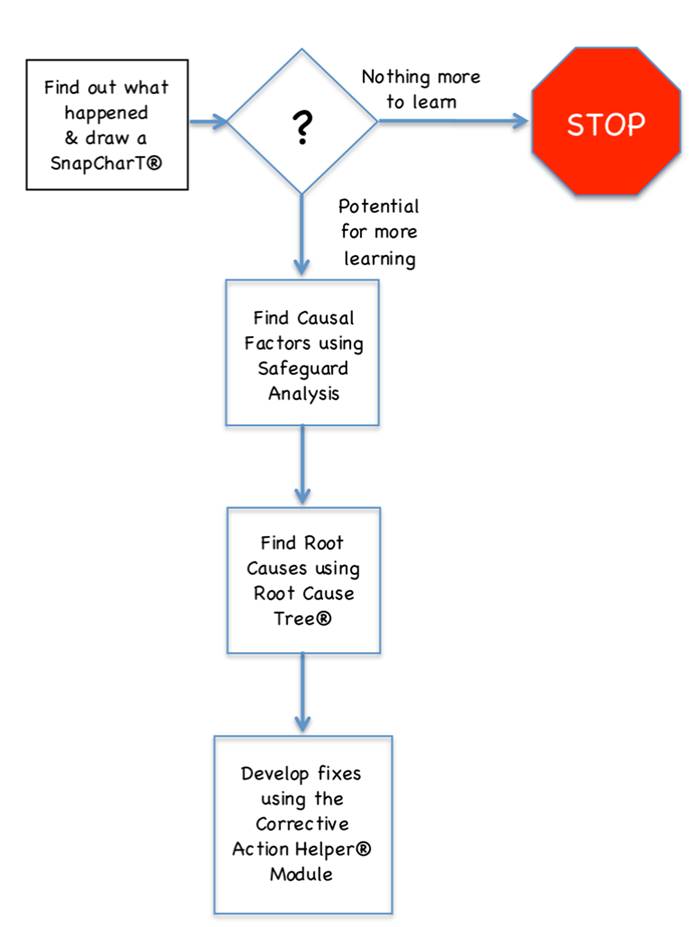Using TapRooT® for Simple Investigations


– Required by regulators or law
– Required by company policy
– Perceived higher return on investment
However, companies often default to less developed (and therefore less accurate) analyses for lower risk, lower consequence problems. For example, almost everyone will perform a TapRooT® investigation when there is a serious injury; this is a high-consequence incident, and preventing it in the future is perceived to have the highest ROI. But what about a near miss? Or maybe someone tripped over an air line on the floor, dropping a repair part and damaging it? Most companies will either not perform any investigation, or they will default to “easy” methods (5-Why’s, etc.). Why spend any time on these “simple” incidents? Let’s just do a quick “analysis” and move on?
While I completely understand this thought process, there are some serious flaws in this thinking.
- Low ROI. While a particular incident may not have caused a large loss, this dos not mean it automatically deserves no attention. Maybe tripping over the air line only caused $800 in damage this time. But what about the other issues that have been caused by poor housekeeping in the past? What if the person had tripped and fallen over the edge of a platform? Making a quick assumption like this can allow you to miss potentially serious issues when taken together. Performing a poor analysis will lead to repeats of the problem.
- Poor results of “quick” RCA methods. Keep in mind that a quick method probably means that you did not gather any information. You are therefore performing an “analysis” without any data to analyze. If your analysis method takes 5 minutes, you have probably just wasted 5 minutes of your time. If you’re going to perform an RCA, make sure it gets to useable and consistent answers.
- TapRooT® is only for the big stuff. This thought often frustrates me. It is true that you will not perform a TapRooT® investigation in 5 minutes. However, any method that purports to give you magic answers in a few minutes is not being honest. See #2 above. However, that does NOT mean that TapRooT® must take days of your time. For simple investigations, the results of a TapRooT® investigation may be found in just an hour or so.
So, how do we use TapRooT® for lower risk or low consequence problems? This year, we have modified the TapRooT® methodology to allow you to use the steps of the process that you need to perform a great investigation on simple problems. This updated process isn’t really new; it just codifies how we’ve taught you to use TapRooT® in the past for these simpler problems. We make the process more efficient and give you the opportunity to optionally skip some of the steps.
Here is the new process flow for low to medium risk incidents:

There are some important points that I wanted to highlight about this new process flow:
- You always start with a SnapCharT®. There is no way to perform any type of analysis unless you first gather some information. Again, any other process that advocates performing an analysis on the information you received in a quick phone call is not a real analysis. The SnapCharT® ensures you have the right information to actually look for root causes.
- There is an off-ramp right at the beginning. Once you’ve gathered information in a SnapCharT®, you can then make an intelligent decision as to whether this problem has the potential to uncover significant problems. You may find, after building your SnapCharT®, that this really was an extremely low potential problem, with minimal consequences. You will then stop the analysis at that point, put simple corrective actions in place to fix what you found, and then document the problem for later trends. That’s it. While most investigations will continue on with the rest of the process, there are some issues that do not require any further analysis and don’t deserve any further resources.
- For most investigations, you will continue by identifying Causal Factors, and run those Causal Factors through the Root Cause Tree®. No different than before.
- For these simpler problems, it probably is not worth the effort of looking for generic causes. We have made this step optional. It you feel the problem has the potential to be more widespread, you can continue to look for generic issues, otherwise, go straight to corrective actions.
- Low to medium risk incidents probably do not need the resources you would normally expend writing full SMARTER corrective actions. We encourage you to write corrective actions based on the guidance in the Corrective Action Helper®, but writing fully SMARTER fixes is probably not necessary.
For more serious incidents, we would still use the full 7-Step TapRooT® Process that you are familiar with. However, for lower risk or lower consequence problems, this abbreviated process flow is much easier to use, allowing you to more quickly work through a TapRooT® investigation. Why use 5-Why’s and get poor results (as expected) just to “save time,” when you can use the simplified TapRooT® process to get MUCH better answers with less effort than before?
The 2-Day TapRooT® Root Cause Analysis Course not only covers this simpler method of performing TapRooT® investigations, but also allows students to perform investigations on any inciden with this efficient process flow.
Choose a course and register here!



